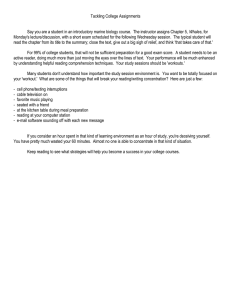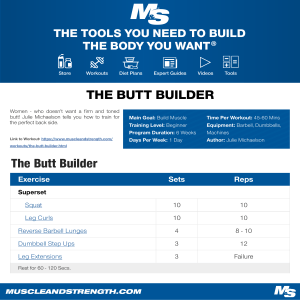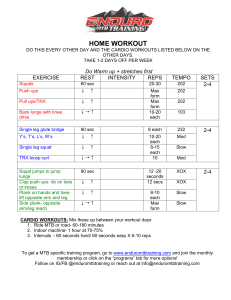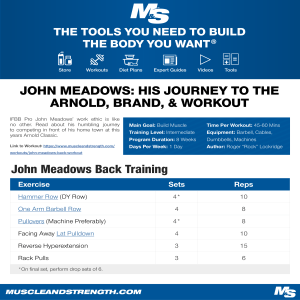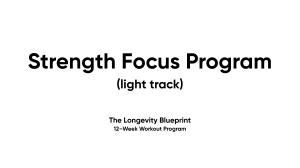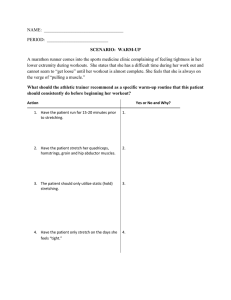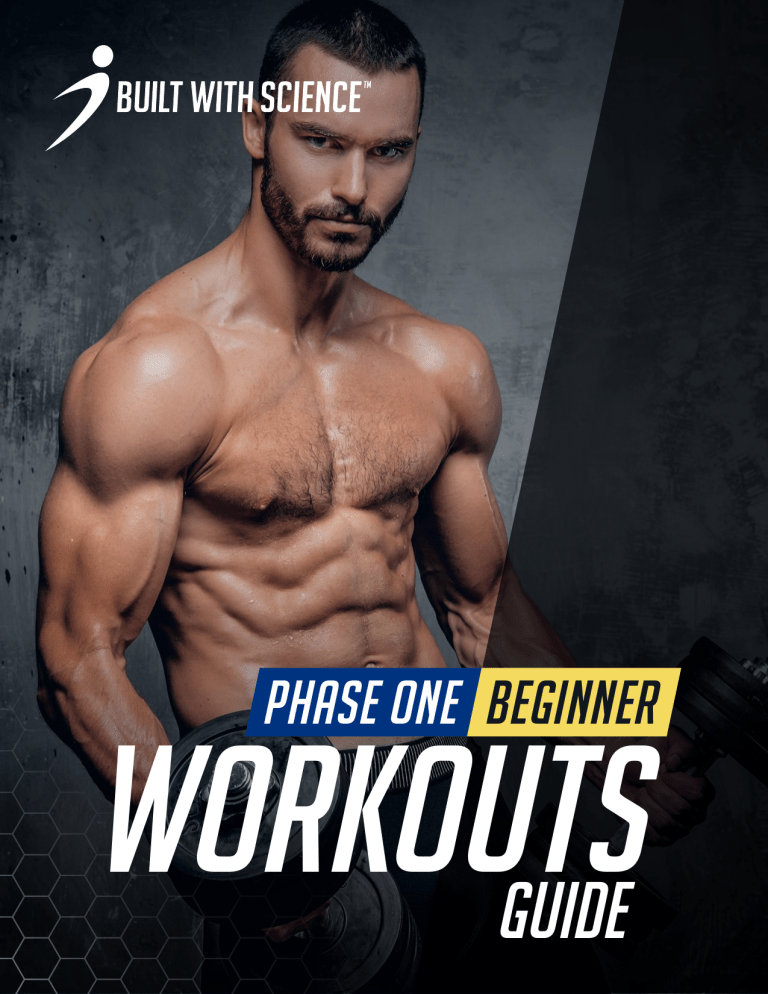
phase one beginner workouts guide PHASE one Workouts Table of contents Phase one Workout Routine 3 WARM UP 4 Warm Up Exercise Tutorials 5 Workout A E1: Bench Press E2: Back Squat E3: Chest Supported Row E4: Dumbbell Lateral Raises E5: Single Leg Weighted Calf Raise 16 17 18 19 20 21 Workout B 22 E1: Incline Dumbbell Press 23 E2: Deadlift (conventional) 24 E3: Standing Overhead Press (Barbell) 25 E4: Pull-Ups 26 E5: Kneeling Face Pulls 27 ADDITIONAL COMMENTS 28 DISCLAIMER 29 @jeremyethier 2 PHASE one Workouts Phase one Workout Routine This PDF is designed to act as a supplemental resource for you to refer to while you’re at the gym. This is NOT a “summary” of the course – meaning that there’s tons of invaluable and essential information within the course chapters that you need to first go through (progressive overload, exercise tutorial videos, mind to muscle connection, how heavy to lift, etc.) before applying the workouts contained within this PDF - otherwise this will be pretty much useless for you to refer to! With that being said, and as explained in the course, for “Phase 1” your weekly routine will look something like this: MONDAY TUESDAY WEDNESDAY THURSDAY FRIDAY SATURDAY SUNDAY Workout A Rest Workout B Rest Workout A Rest Rest MONDAY TUESDAY WEDNESDAY THURSDAY FRIDAY SATURDAY SUNDAY Workout B Rest Workout A Rest Workout B Rest Rest The exact days don’t matter for your workouts, but the key is to get at least one rest day in between each workout, getting 3 workouts in per week, and ensuring that you’re rotating between Workouts A and B. Your abs/cardio routine can be done after any of the workouts OR on a rest day. Refer to those chapters for further guidance. @jeremyethier 3 PHASE one Workouts WARM UP FULL-BODY WARM-UP ROUTINE (~5 MINUTES) Exercise Reps Notes Wrist Circles 10 each direction Keep palms together, circle in both directions. Arm Circles 10 each direction Forward and reverse direction. Band Over-and-Backs 5 Widen grip to make it easier, avoid arching the back. Band Pull-Aparts 10 Overhand grip, squeeze shoulder blades together. Band External Rotation 10-15 per side Keep elbow against your side, rotate outward, use light weight. DB Shoulder Extensions 10-15 per side Keep elbow locked in place, rotate hand up, use light weight. Forward & Back Leg Swings 10-15 per side Swing leg front and back, keep core tight. Side-to-Side Leg Swings 10-15 per side Swing leg side to side, keep core tight. Spiderman Lunge with Thoracic Extension 5 per side Start in plank position, foot placed outside hand, rotate arms up. Wall Ankle Mobilization 5 per side, 2 second hold Keep heel on the ground, lean forward, hold end stretch for 2 seconds. WARM UP SETS (only for the first upper and lower body exercise): Set Weight Reps Rest 1 50% working weight 8 45-60 seconds 2 70% working weight 3-4 45-60 seconds 3 90% working weight 1 2 minutes BEGIN WORKING SETS @jeremyethier 4 PHASE one Workouts Warm Up Exercise Tutorials 1. Wrist Circles x10 each direction Why To warm up and mobilize the wrist muscles which will be heavily involved in many exercises. How Clasp your palms together and move your wrists in a circular motion for 10-15 reps in both directions. @jeremyethier 5 PHASE one Workouts Warm Up Exercise Tutorials 2. Arm Circles x10 Forward and Back Why To warm up and mobilize the shoulder joint. How Swing your arms forward in a circular motion for 10-15 reps and then repeat in the reverse direction. @jeremyethier 6 PHASE one Workouts Warm Up Exercise Tutorials 3. Band Over-and-Backs x5 Why To mobilize the chest/shoulder area and help with shoulder/scapular stability. How Hold your band at a little wider than shoulder-width apart. Bring the band over your head and back behind your body while keeping your arms straight. Keep the tension even as you move the band behind you (don’t “release the slack” by relaxing or resting your hands on your back/butt), and then bring it back over your head into the starting position. If this is too difficult, widen your hand position. When it gets too easy, narrow your hand position. Avoid arching your back as you perform the movement by slightly contracting your core. @jeremyethier 7 PHASE one Workouts Warm Up Exercise Tutorials 4. Band Pull-Aparts x10 Why To warm up the mid-back and rotator cuff musculature to help with your pressing. How Hold your band at around shoulder-width apart with an overhand grip. Pull the band apart by squeezing your shoulder blades together. Keep your upper traps relaxed as you do so and focus on feeling your mid-back muscles working. Control back to the starting position and repeat. You can use just one strand of the band OR a wider grip to make it easier, then narrow your grip overtime. @jeremyethier 8 PHASE one Workouts Warm Up Exercise Tutorials 5. Band External Rotation x10-15 per side Why To warm up the rotator cuff muscles. How Use either a band attached to a pole or a pulley system with the handle set up at elbow height. Stand beside the cable pulley or band and externally rotate the shoulder while keeping your elbow at 90 degrees and pinned to the side of your body. Control back to the starting position and repeat. @jeremyethier 9 PHASE one Workouts Warm Up Exercise Tutorials 6. DB Shoulder Extensions x10-15 per side Why To further warm up the rotator cuff muscles. How Using a light dumbbell in one arm, bring your arm up to shoulder height and bend your elbow to 90 degrees. Externally rotate your shoulder such that the dumbbell is lifted towards the ceiling, but keep your elbow locked in its position. @jeremyethier 10 PHASE one Workouts Warm Up Exercise Tutorials 7. Forward & Back Leg Swings x10-15 per side Why To mobilize and warm up the hips and leg muscles for your leg movements. How Keep your core tight and hold onto something beside you. Swing your leg front and back as far as your leg will go. @jeremyethier 11 PHASE one Workouts Warm Up Exercise Tutorials 8. Side-to-Side Leg Swings x10-15 per side Why To mobilize and warm up the hips and leg muscles for your leg movements. How Keep your core tight and hold onto something beside you. Swing your leg front and back as far as your leg will go. @jeremyethier 12 PHASE one Workouts Warm Up Exercise Tutorials 9. Spiderman Lunge w/ Thoracic Extension x5 each side Why To mobilize and warm up the thoracic spine and hips. How Start in a plank position with your palms on the ground and shoulder-width apart. Take a lunge forward with one leg such that your foot is placed on the outside of the corresponding hand. The back leg can be bent with your knee on the ground. Next, stay in this position and then rotate your torso and lift one arm towards the sky to try to create a straight line between your arms. Do this for both arms (rotate both ways) and then come back to the starting position and repeat with the other leg – this count as 1 rep. @jeremyethier 13 PHASE one Workouts Warm Up Exercise Tutorials 10. Wall Ankle Mobilization x5 each side w/ 2 second hold Why To mobilize the ankles which tends to limit squat depth/mobility in most people. How Position yourself in front of a wall with one foot ahead and one foot behind. Lean your body forward such that your front knee moves towards the wall (it can touch the wall at the end position). Hold the stretch for 2 seconds, then move back to the starting position. Ensure the heel of your front foot remains on the ground throughout each rep. Repeat with both sides. @jeremyethier 14 phase one beginner workouts guide PHASE one Workouts Workout A Exercise Barbell Bench Press Back Squat Sets 3 4 Reps 8-10 8-10 Rest (min) Notes 2.5-3 Try pinky on rings, keep shoulderblades retracted, maintain lower back arch, press from below nipples to above shoulders. 3 Experiment with foot stance, point toes slightly out, maintain a straight back, squat to at least parallel. Chest-Supported Row 3 8-10 2 Pull with elbows, squeeze shoulder-blades together, don’t flare elbows out. Dumbbell Lateral Raises 3 10-15 ~45-60 seconds Lean torso forward, retract shoulder blades, externally rotate shoulder (“thumbs up” slightly). Single Leg Weighted Calf Raise 4 6-10 1-1.5 Pause at bottom of each rep, use full range of motion. @jeremyethier 16 PHASE one Workouts Workout A E1: Bench Press STEP 1 (POSITIONING) Lie down on the bench so that the bar is sitting directly over your eyes. Grab the bar with a width such that your pinky’s just inside the ring marks (but experiment and see what grip-width works best for you). Raise your chest up towards the ceiling and squeeze your shoulder-blades back and down by pinching your shoulder blades together. Keep your butt on the bench. Bring your feet back under your knees and plant them firmly on the ground. As a result, there should be space between your lower back and the bench (an arch). Squeeze your glutes to help you maintain a stable position. STEP 2 (UNRACK) Straighten your arms to lift the bar up. Move the bar so that it’s balanced directly over your shoulders. STEP 3 (DESCEND) Lower the bar to slightly below your nipples while slightly tucking your elbows and keeping your forearms vertical and directly under your wrists. Make sure to use full range of motion such that the bar physically touches your chest at the bottom. STEP 4 (PRESS) Press the bar from below your nipples to directly above your shoulders. The bar should not travel straight up and down, but rather slightly back towards the starting position. Focus on moving the weight by squeezing your chest together (think about trying to bring your biceps together). Your shoulder-blades should be retracted and pulled down throughout the press, and your butt should remain in contact with the bench. @jeremyethier 17 PHASE one Workouts Workout A E2: Back Squat STEP 1 (PLACEMENT) Grab the bar with an overhand grip slightly wider than shoulder-width. Place the bar on your upper-back (traps) by dipping under the bar. Raise your chest up and retract your shoulder blades. STEP 2 (UNRACK) Unrack the bar, take 3 steps back, then adjust your footing. Your feet should be shoulder-width apart or a little wider. You can point your toes out slightly if this is more comfortable. But play around with foot positioning to find what’s comfortable for you. STEP 3 (DESCENT) Take a deep breath in and hold it. You want to use this breath to brace your core (think about contracting your abs how you would if someone were to punch your stomach). Move your hips back while bending your knees to squat down. Squat down until your thighs are at least parallel to the ground. If you have the mobility to do so, then you can go further below parallel. STEP 4 (ASCENT) Squat back up by pushing through your heels. Keep your knees in line with your toes by thinking about “spreading the floor apart” with your feet. Avoid creeping up on your toes or collapsing your knees inward. Keep your lower back neutral and your chest up. You can exhale as you press up, or keep your breath held and then exhale at the top position. Then repeat for more reps. @jeremyethier 18 PHASE one Workouts Workout A E3: Chest Supported Row This can be done on a T-bar supported row machine or any other chest-supported variation STEP 1 (SETUP) Lie flat on an incline bench with your weighted bar on the ground. Grab the bar with an overhand thumb-less grip a little wider than shoulder-width apart. STEP 2 (PULL) Pull the bar up towards your “upper abdominal area” as far as the bench will allow you to go. Focus on squeezing your shoulder-blades together in order to pull the weight and try to relax your upper traps as best as possible. Additional Tips Your head should remain in a neutral position relative to your spine, rather than sticking out forward. Your elbows should make a 90-degree angle when at the top position to minimize wrist/elbow stress and really think about pulling with your elbows each rep in order to better activate your back. They should also remain tucked as opposed to flared out during each rep. STEP 3 (DESCENT) Control the weight down as opposed to letting it simply drop. Flex the triceps at the bottom position and then repeat for more reps. @jeremyethier 19 PHASE one Workouts Workout A E4: Dumbbell Lateral Raises As shown in my shoulder workout video, these can be done either standing or on an incline bench. The instructions below are for the standing version but the same tips will apply if you wish to do them on the bench. STEP 1 (SETUP) Grab a dumbbell in each hand, then slightly lean forward by slightly bending your knees and bringing your hips back. Depress your upper traps by bringing your shoulders down and away from your ears. Retract your shoulder-blades by pinching them together. You want to maintain this position throughout each rep. STEP 2 (RAISE) Raise both dumbbells out to the side until they reach about shoulder-height. But raise the dumbbells such that your shoulders are slightly externally rotated (such that your thumbs are pointed slightly towards the ceiling). Think about raising the weight “out” towards your sides as much as possible opposed to “up”. Don’t use any momentum to swing the weight up. STEP 3 (DESCEND) Control the weight down to the starting position and repeat. Optional: You can perform these while lying on an incline bench instead – but use the same pointers previously described. @jeremyethier 20 PHASE one Workouts Workout A E5: Single Leg Weighted Calf Raise STEP 1 (SETUP) Stand with the toes of one foot on an elevated platform and a weight held in the opposite hand. Ideally, you should be holding onto something for balance with your free hand. Start with your heel touching the floor. STEP 2 (RAISE) By using your calves, lift directly straight up on your toes as high as possible. Pause for half a second at the top position. STEP 3 (DESCENT) Slowly lower your heel back down to the ground. Pause for half a second at the bottom position before performing another rep. If adding weight is too difficult for you, perform them with just your bodyweight until you gain the calf strength to add weight. @jeremyethier 21 PHASE one Workouts Workout B Exercise Sets Reps Rest (min) Notes Incline Dumbbell Press 3 10-12 2-3 Experiment with bench angles (~15-45 degrees), keep shoulder blades retracted & chest sticking out, don’t flare elbows. Deadlift 3 6-8 3 Maintain straight back, keep head/back/hips in line. 2-3 Press in a straight line up, keep core engaged, no momentum, don’t arch lower back. 2-3 Wider than shoulder-width thumb-less grip, pull with elbows, use full ROM (eyes over bar), add weight if possible. 1.5-2 Keep upper traps relaxed, pull towards face while raising fists towards ceiling (external rotation). Standing Overhead Press Pull-Ups* Kneeling Face Pulls 3 3 4 8-10 8-10 10-15 *If you’re unable to do pull-ups within the desired rep range, swap them for lat-pulldowns. @jeremyethier 22 PHASE one Workouts Workout b E1: Incline Dumbbell Press STEP 1 (BENCH ANGLE) Set up an incline bench so that it’s at roughly a 30-degree angle which seems to be optimal based on the literature (Lauver et al. 2015). But I would suggest trying out various angles to see which best activates your upper chest. For shoulder-dominant pressers, you might even find that a very low incline of 15 or 20 degree angle activates your chest better. STEP 2 (SETUP) Using your thighs to push the dumbbells up, kick up one dumbbell at a time so that you can get them into the starting position. As with the bench press, stick your chest up towards the ceiling and pinch your shoulder blades together while depressing your upper traps by bring your shoulders down and away from your ears). There should be a slight arch between your lower back and the bench. You need to maintain this position throughout the lift. STEP 3 (PRESS) Press up by thinking about “squeezing your biceps together” to better activate your chest. Ensure your shoulder-blades remain retracted and tight. Keep your elbows slightly tucked as you press, and press up until the dumbbells almost touch. STEP 4 (DESCENT) Slowly lower the weight until the end of the dumbbells just about touch your chest. Make sure your shoulder blades are retracted and tight before performing another rep. @jeremyethier 23 PHASE one Workouts Workout b E2: Deadlift (conventional) STEP 1 (SETUP) Stand with your mid-foot under the bar when looking down. Your feet should be about hip-width apart (or slightly wider) and toes can be slightly pointed out. The stance is a little narrower than that of the squat. Bend over at the hips and grab the bar with an overhand grip that is about shoulder-width apart or just outside of your shins. Your arms should be straight. STEP 2 (STARTING POSITION) Drop into the starting position by bending your knees and lifting your chest until your back is straight. The bar should be as close to your shins as possible and should still be over your mid-foot. This is your starting position – with your head in line with your back and hips and your lower back straight. Also note that your butt should be between your knees and head, rather than too low or too high. STEP 3 (PULL) Take a deep breath in and hold this breath. You want to use this breath to brace your core (think about contracting your abs how you would if someone were to punch your stomach). Pull slightly until you feel tension with the bar, then pull the weight off the floor by straightening your legs and pushing your hips forward simultaneously. Keep the bar as close as possible to your legs as you pull up – the bar should travel in a vertical path. Don’t round your back as you pull. Breathe out at the top. STEP 4 (DESCENT) Return the weight to the floor by first bending at the hips and then by bending the knees. Again, the bar should be as close to the legs as possible. I’d suggest letting the weight come to a dead stop on the floor and then readjusting your form before your next rep. Once you get better at the deadlift, you can perform your reps in more of a continuous fashion (e.g. “touch and go”). @jeremyethier 24 PHASE one Workouts Workout b E3: Standing Overhead Press (Barbell) STEP 1 (SETUP) Set up your rack such that the bar is around shoulder height. Grab the bar with an overhand grip slightly wider than shoulder-width. The key for grip is to ensure your wrists are straight and your forearms are vertical when the bar is in the starting position – so the grip width will vary based on the individual. STEP 2 (PREPARING THE PRESS) Lift the bar off the rack and take a couple steps away from the rack (keep in mind that normally you’d be stepping backwards, I just had to unrack it forwards in order to show you the positioning). Engage your core by contracting your abs slightly (think about as if someone was about to punch your stomach) and squeeze your glutes. STEP 3 (PRESS) Take a deep breath in, hold it, and then press the bar up. You’ll have to ensure your head is not sticking forward in order to do so. Once the bar passes the top of your head, you can move your head forward (“look through the window”) to allow the bar to be directly over your head in the finishing position. Don’t use momentum with your legs as you and make sure that you aren’t arching your lower back when pressing. A little bit of an arch is fine as long as it’s not excessive, just make sure that your core still remains tight and engaged. STEP 4 (DESCEND) Bring the bar to your shoulders after each rep while exhaling your breath. @jeremyethier 25 PHASE one Workouts Workout b E4: Pull-Ups STEP 1 (SET UP) Grab the pull-up bar with an overhand grip slightly wider than shoulder-width – I’d suggest using a “thumb-less grip” as it usually helps better activate the back. Next, depress your upper traps and keep them this way as you pull. STEP 2 (PULL) Pull yourself up by pulling your elbows down to the floor, you want to think about pulling with your elbows as opposed to pulling with your hands. It’s preferred to keep your feet straight down throughout the pull-up, but if your pull-up bar doesn’t allow this then it’s perfectly fine to cross your feet over and bend your knees. STEP 3 (TOP POSITION) You want to pull such that at least your eyes reach over the bar – and at this point, you want to ensure that your shoulders are not rounding forward (internally rotating) and are instead retracted back. STEP 4 (DESCENT) Lower your body in a controlled manner until your arms are straight, and then repeat for another rep. As soon as you’re able to perform 8 or more bodyweight pull-ups in one set, I’d suggest adding a little bit of weight by either using a weight belt or holding a dumbbell between your feet then continue adding more weight overtime. @jeremyethier 26 PHASE one Workouts Workout b E5: Kneeling Face Pulls STEP 1 (SET UP) Set up a cable system so that the notch is a couple notches below from the very top. Grab the rope with an overhand grip, then get down on one knee. Relax your upper traps by bringing your shoulders down and away from your ears. You want to maintain this throughout each rep. STEP 2 (PULL) Pull the rope towards your face while keeping your elbows high. Think about pulling with your elbows and squeezing your shoulder-blades together, and as you pull, you want to externally rotate your shoulder such that your knuckles are facing the ceiling. STEP 2 (PULL) You can see what I mean here at this angle, the end position is as if you were holding a “biceps flexing pose”. This helps further target the rotator cuff. STEP 3 (ECCENTRIC) Control the weight back to the starting position and then repeat for another rep. Ensure that you aren’t excessively arching or rounding your back during each rep. You should feel a strong contraction in the middle of your back. @jeremyethier 27 PHASE one Workouts ADDITIONAL COMMENTS For inquiries or customer support, email contact@builtwithscience.com For exercise tutorial videos of all the exercises in this program, please visit the exercise tutorial section of your program where in-depth videos are provided for each. And as mentioned in your program, after successful completion of phase 1, you can transition to phase 2 where volume will be increased to further your progression at the optimal rate. However, it’s important that you only do so once you’re ready. I discuss how to know when you’re ready in the workout chapter of your program, so refer to that for more detail. Enjoy! @jeremyethier 28 PHASE one Workouts DISCLAIMER The content provided in this PDF is for informational and educational purposes only. Jeremy Ethier is not a medical doctor, psychologist, therapist, nutritionist, or registered dietitian. The contents of this document should not be construed as medical, psychological, dietary, nutritional, or healthcare advice of any kind. The contents of this document are not intended to diagnose, treat, cure, or prevent any health conditions, nor are they intended to replace a physician, dietitian, nutritionist, or other qualified healthcare professional’s advice. You should always consult your physician, dietitian, or other qualified healthcare professional on any matters regarding your health, engagement in physical activity, and/or diet before starting any fitness program or meal plan to determine if it is suitable for your needs. This is especially important if you (or your family members) have a history of high blood pressure or heart disease, if you have ever experienced chest pain while exercising, or if you have experienced chest pain in the past month when not engaged in physical activity. You should also consult your physician, dietitian, or other qualified healthcare professional before starting any fitness program, meal plan, or dietary regimen if you smoke, have high cholesterol, are obese, or have a bone or joint problem that could be made worse by a change in physical activity or diet. Do not start or continue any fitness program, meal plan, or dietary regimen if your physician, dietitian, or health care provider advises against it. If you experience faintness, dizziness, pain, shortness of breath or any other form of discomfort at any time while exercising or while following any meal plan/dietary regimen, you should stop immediately. If you are in Canada and think you are having a medical or health emergency, call your health care provider, or 911, immediately. @jeremyethier Please note the following: • any and all exercise that you do as a result of what you read in this PDF shall be performed solely at your own risk; • any and all meal plans that you follow or adhere to as a result of what you read in this PDF shall be used solely at your own risk; and • any and all foods or beverages that you consume as a result of what you read in this PDF shall be consumed solely at your own risk. No part of this report may be reproduced or transmitted in any form whatsoever, electronic or mechanical, including photocopying, recording, or by any informational storage or retrieval system without the express written, dated, and signed permission from the author (Jeremy Ethier). All copyrights are reserved. Built With Science™ may not be copied or used for any purpose without express written consent. 29 PHASE one Beginner Workouts guide
